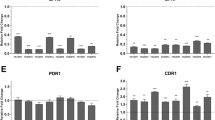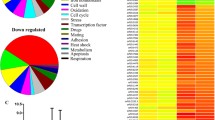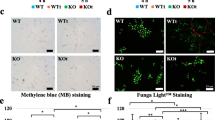Abstract
In eukaryotes, loss of cytoplasmic ribosomal proteins (RPs) results in a reduced growth rate and other phenotypic defects. The ability to transition from a unicellular budding yeast to a filamentous form is very important for biofilm formation and virulence in Candida albicans. Our recent study found that loss of the RPS41 (C2_10620W_A) gene but not its paralog RPS42 (C1_01640W_A) resulted in altered growth and filamentation changes in C. albicans, so we hypothesized that the RPS41 gene should play important roles in virulence and biofilm formation in this pathogen. We found that both virulence and the ability to form biofilms were defective due to deletion of the RPS41 gene. We also found that loss of the RPS41 gene increased sensitivity to hydrogen peroxide, and that hydrogen peroxide induced the expression of the RPS41 gene in a wild-type strain. These results suggested that the RPS41 gene plays important roles in C. albicans biofilm formation, virulence, and susceptibility to hydrogen peroxide.




Similar content being viewed by others
References
Alonso-Monge R, Roman E, Arana DM, Prieto D, Urrialde V, Nombela C, Pla J (2010) The Sko1 protein represses the yeast-to-hypha transition and regulates the oxidative stress response in Candida albicans. Fungal Genet Biol 47(7):587–601
Bensen ES, Filler SG, Berman J (2002) A forkhead transcription factor is important for true hyphal as well as yeast morphogenesis in Candida albicans. Eukaryot Cell 1(5):787–798
Brand A, MacCallum DM, Brown AJ, Gow NA, Odds FC (2004) Ectopic expression of URA3 can influence the virulence phenotypes and proteome of Candida albicans but can be overcome by targeted reintegration of URA3 at the RPS10 locus. Eukaryot Cell 3(4):900–909
Byrne ME (2009) A role for the ribosome in development. Trends Plant Sci 14(9):512–519
Cao Y, Dai B, Wang Y, Huang S, Xu Y, Cao Y, Gao P, Zhu Z, Jiang Y (2008) In vitro activity of baicalein against Candida albicans biofilms. Int J Antimicrob Agents 32(1):73–77
Du H, Guan G, Xie J, Sun Y, Tong Y, Zhang L, Huang G (2012) Roles of Candida albicans Gat2, a GATA-type zinc finger transcription factor, in biofilm formation, filamentous growth and virulence. PLoS One 7(1):e29707
Huang G (2012) Regulation of phenotypic transitions in the fungal pathogen Candida albicans. Virulence 3(3):251–261
Jackson S, Coulthwaite L, Loewy Z, Scallan A, Verran J (2014) Biofilm development by blastospores and hyphae of Candida albicans on abraded denture acrylic resin surfaces. J Prosthet Dent 112(4):988–993
Lo HJ, Kohler JR, DiDomenico B, Loebenberg D, Cacciapuoti A, Fink GR (1997) Nonfilamentous C. albicans mutants are avirulent. Cell 90(5):939–949
Lu H, Yao XW, Whiteway M, Xiong J, Liao ZB, Jiang YY, Cao YY (2015) Loss of RPS41 but not its paralog RPS42 results in altered growth, filamentation and transcriptome changes in Candida albicans. Fungal Genet Biol 80:31–42
Lu H, Zhu YF, Xiong J, Wang R, Jia Z (2015) Potential extra-ribosomal functions of ribosomal proteins in Saccharomyces cerevisiae. Microbiol Res 177:28–33
Lu H, Zhu Z, Dong L, Jia X, Sun X, Yan L, Chai Y, Jiang Y, Cao Y (2011) Lack of trehalose accelerates H2O2-induced Candida albicans apoptosis through regulating Ca2+ signaling pathway and caspase activity. PLoS One 6(1):e15808
Nasution O, Srinivasa K, Kim M, Kim YJ, Kim W, Jeong W, Choi W (2008) Hydrogen peroxide induces hyphal differentiation in Candida albicans. Eukaryot Cell 7(11):2008–2011
Ramage G, Lopez-Ribot JL (2005) Techniques for antifungal susceptibility testing of Candida albicans biofilms. Methods Mol Med 118:71–79
Spahn CM, Beckmann R, Eswar N, Penczek PA, Sali A, Blobel G, Frank J (2001) Structure of the 80S ribosome from Saccharomyces cerevisiae–tRNA-ribosome and subunit-subunit interactions. Cell 107(3):373–386
Staab JF, Sundstrom P (2003) URA3 as a selectable marker for disruption and virulence assessment of Candida albicans genes. Trends Microbiol 11(2):69–73
Strittmatter AW, Fischer C, Kleinschmidt M, Braus GH (2006) FLO11 mediated filamentous growth of the yeast Saccharomyces cerevisiae depends on the expression of the ribosomal RPS26 genes. Mol Genet Genomics 276(2):113–125
Szakonyi D, Byrne ME (2011) Ribosomal protein L27a is required for growth and patterning in Arabidopsis thaliana. Plant J 65(2):269–281
Tseng TL, Lai WC, Lee TL, Hsu WH, Sun YW, Li WC, Cheng CW, Shieh JC (2015) A role of Candida albicans CDC4 in the negative regulation of biofilm formation. Can J Microbiol 61(4):247–255
Uppuluri P, Pierce CG, Thomas DP, Bubeck SS, Saville SP, Lopez-Ribot JL (2010) The transcriptional regulator Nrg1p controls Candida albicans biofilm formation and dispersion. Eukaryot Cell 9(10):1531–1537
Vazquez-Torres A, Balish E (1997) Macrophages in resistance to candidiasis. Microbiol Mol Biol Rev 61(2):170–192
Wang Y, Jia XM, Jia JH, Li MB, Cao YY, Gao PH, Liao WQ, Cao YB, Jiang YY (2009) Ascorbic acid decreases the antifungal effect of fluconazole in the treatment of candidiasis. Clin Exp Pharmacol Physiol 36(10):e40–e46
Yeater KM, Chandra J, Cheng G, Mukherjee PK, Zhao X, Rodriguez-Zas SL, Kwast KE, Ghannoum MA, Hoyer LL (2007) Temporal analysis of Candida albicans gene expression during biofilm development. Microbiology 153(Pt 8):2373–2385
Acknowledgments
This work is supported by the Natural Science Foundation of China (Grant Nos. 81271798 and 81401552), the State Key Program of National Natural Science of China (81330083), and China National 973 Program (2013CB531602). We would like to acknowledge Malcolm Whiteway (Concordia University, Canada) for the helpful discussion about this study and a critical review of this manuscript. We would also like to thank Professor William A. Fonzi for kindly providing the C. albicans strains CAI4.
Author information
Authors and Affiliations
Corresponding authors
Ethics declarations
Conflict of Interest
The authors declare no conflict of interest.
Electronic supplementary material
Below is the link to the electronic supplementary material.
Rights and permissions
About this article
Cite this article
Lu, H., Xiong, J., Shang, Q. et al. Roles of RPS41 in Biofilm Formation, Virulence, and Hydrogen Peroxide Sensitivity in Candida albicans . Curr Microbiol 72, 783–787 (2016). https://doi.org/10.1007/s00284-016-1019-7
Received:
Accepted:
Published:
Issue Date:
DOI: https://doi.org/10.1007/s00284-016-1019-7




